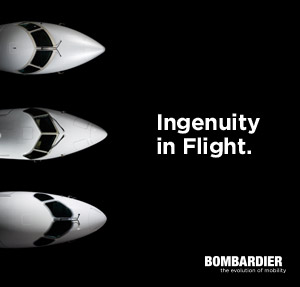Hamilton Sundstrand’s Boeing 787 Auxiliary Power Unit Undergoes Successful Initial Start-up
May 18, 2009
WINDSOR LOCKS, Conn., May 18 /PRNewswire/ — The Hamilton Sundstrand APS 5000 Auxiliary Power Unit (APU) for the Boeing 787 Dreamliner had a successful initial start-up on Boeing’s ZA001 development aircraft Tuesday, May 12. The testing took place at Boeing’s Everett, Wash., facility. Hamilton Sundstrand is a subsidiary of United Technologies Corp. (NYSE: UTX).
“Hamilton Sundstrand is pleased to partner with the Boeing team to help achieve this success for the 787 Dreamliner,” said Tim Morris, Hamilton Sundstrand president, 787 Programs. “Our employees have been committed to this program’s success since its inception. We are all extremely proud to see it come to fruition.”
APUs provide power to aircraft while they are on the ground, and provide in-flight back-up power. The APS 5000 APU is rated at 1,100 shaft horsepower and is designed to start and operate throughout the full range of the 787 operating envelope up to 43,000 feet. The APS 5000 is Boeing’s first more-electric APU. It produces 10 percent fewer emissions and is 50 percent quieter than current Boeing 767 APUs. Hamilton Sundstrand Power Systems, based in San Diego, Calif., has more than 13,000 APUs in commercial and military service.
The APS 5000 has accumulated 6,020 hours – including nearly 14,000 starts – in the qualification program and has demonstrated outstanding performance during cold weather and high temperature testing, icing and snow testing, altitude simulation and high vibration endurance testing.
In addition to the APU, Boeing chose Hamilton Sundstrand to provide the 787’s environmental control system, electric power generation and start system, remote power distribution system, primary power distribution system and high-voltage DC equipment racks, emergency power system, nitrogen generation system, and electric pump subsystem. Hamilton Sundstrand’s Kidde Aerospace & Defense business is supplying Boeing with the complete fire protection systems package for the 787. Rolls-Royce also chose Hamilton Sundstrand to supply the gearbox system for its Trent 1000 engine. The 787 program is expected to generate more than $15 billion in revenue for Hamilton Sundstrand over the life of the program.
With 2008 revenues of $6.2 billion, Hamilton Sundstrand employs approximately 18,000 people worldwide and is headquartered in Windsor Locks, Conn. Among the world’s largest suppliers of technologically advanced aerospace and industrial products, the company designs, manufactures and services aerospace systems and provides integrated system solutions for commercial, regional, corporate and military aircraft. It also is a major supplier for international space programs.
United Technologies Corp., based in Hartford, Conn., is a diversified company providing high technology products and services to the building and aerospace industries worldwide.
Pratt & Whitney F135 STOVL Exceeds and Completes Vertical Thrust Requirement
May 18, 2009
EAST HARTFORD, Conn., May 18 /PRNewswire-FirstCall/ — The Pratt & Whitney F135 short takeoff/vertical landing (STOVL) variant propulsion system, which includes the Rolls-Royce LiftSystem(R), has exceeded thrust performance expectations in recently completed tests, providing more vertical power than required by the F-35 Lightning II STOVL aircraft. The testing was conducted on a specially instrumented “hover pit” at Lockheed Martin in Fort Worth, Texas. Pratt & Whitney is a United Technologies Corp. (NYSE: UTX) company.
“The F135 engine continues to exceed performance expectations to deliver the most advanced, capable fifth generation fighter engine for the F-35,” said Warren Boley, vice president, Pratt & Whitney F135/F119 Programs. “The engine demonstrated 41,100 pounds of vertical thrust against our requirement of 40,550 pounds. This means we will deliver excellent margin for the vertical landing and short takeoff performance for our STOVL customers.”
During hover-pit testing, the aircraft is anchored to a metal grate 14 feet above a sloped concrete floor, separating the jet from ground effect and enabling it to simulate free-air flight. Sensors measure thrust and the aircraft’s response to pilot inputs. This is a highly integrated software driven airplane where the testing also demonstrates functional operation of all systems required for vertical flight. This includes control of the doors associated with the STOVL propulsion system: engine auxiliary inlet, LiftFan inlet, LiftFan exit, roll posts, and doors that open to enable the Rolls-Royce three-bearing swivel duct to articulate and vector engine thrust. The hover-pit tests are the final series of ground tests before airborne STOVL testing begins. The F135 STOVL propulsion system includes the Pratt & Whitney main engine and the Rolls-Royce LiftSystem components.
For eight years and more than 11,300 test hours, Pratt & Whitney has been designing, developing and testing the F135 to deliver the most advanced fifth generation fighter engine for the U.S. Air Force, Marine Corps and Navy, as well as eight international partner countries.
The F135 propulsion system is the power of choice for the F-35 and has proven it can meet diverse aircraft requirements. The ground and flight test experience demonstrates the maturity and the associated reliability of the F135 engine for armed forces around the world.
Hubble Servicing Crew to Hold News Conference From Space
May 18, 2009
HOUSTON, May 18 /PRNewswire-USNewswire/ — The seven astronauts aboard space shuttle Atlantis will hold a news conference at 9:26 a.m. CDT on Wednesday, May 20, to discuss their mission to upgrade the Hubble Space Telescope.
Reporters may ask questions from NASA’s Johnson Space Center in Houston, Kennedy Space Center in Florida, Goddard Space Flight Center in Greenbelt, Md., and NASA Headquarters in Washington.
Hawker Beechcraft Sets Industry Standard for Sustainability
May 18, 2009
|
|||||||||
|
|||||||||
AVIDYNE ANNOUNCES FIRST DELIVERY OF ENTEGRA RELEASE 9 IN A CIRRUS SR22 AIRCRAFT
May 18, 2009
Retrofit installation of the Entegra Release 9 system completed in under two weeks; Entegra Release 9 Upgrade provides Cirrus owners with the easiest-to-use IFR flight deck system available.
Lincoln, MA, May 19, 2009–– Avidyne Corporation, a leading provider of integrated flight deck and safety systems for general aviation aircraft, announced today that they have completed and delivered the first customer retrofit of their new Entegra Release 9 Integrated Flight Deck (IFD) system in a Cirrus SR22 aircraft.
“This Entegra Release 9 installation was started just days after we received our Supplemental Type Certificate (STC) approval and the time from aircraft arrival to customer delivery was under two weeks,” said Patrick Herguth, Avidyne’s Chief Operating Officer. “This installation validates the well thought out and time-saving benefits of our pre-fabricated retrofit wiring harness and our highly-detailed retrofit instructions, which were designed to reduce aircraft down time and overall installation costs. For a first-customer installation, it really could not have gone much smoother.”
“Entegra Release 9 is the culmination of years of research and development and we are delighted with the results, having created the easiest-to-use flight deck in all of aviation,” said Dan Schwinn, Avidyne’s President and CEO. “Entegra owners now have access to all the benefits of the Release 9 upgrade and they only have to be without their aircraft for a short amount of time in order to get it.”
“This program is a real credit to the efforts of our entire development team. Aircraft arrival to first flight was accomplished in one week, and we had customer delivery within two weeks,” said Rob Higby, Avidyne’s Vice President of Sales, Marketing and Customer Service. “With Entegra Release 9, we have an ‘Installation Made Simple’ solution to ensure an easy upgrade with predictable down time.”
Another International Success for Elbit Systems Weapon Stations: Elbit Systems Awarded EUR25 Million Contract to Supply Austrian Army With 12.7mm Weapon Stations
May 18, 2009
|
|||||||||
|
|||||||||
Aerosur plans to enhance its international services
May 18, 2009
The Bolivian privately owned airline has announced that due to the competition on domestic routes from Bolivia’s state owned Boliviana de Aviacion (BoA), it plans to launch additional international service. It is currently operating the route between New York-Miami-Havana and is looking at Panama and Colombia as well as new destinations in Europe beyond its present service to Madrid.
Pluna will reinstate flights between Montevideo and Bariloche, Argentina
May 18, 2009
Uruguay’s “born again” airline has announced that it plans to reinstate nonstop flights to Bariloche in Argentina later this year. It plans to build its hub in Montevideo by offering one stop service between Sao Paulo and Bariloche. This is all part of the airline’s plans to continue to build its hub in Montevideo. No date has been announced.
Copa Airlines to depart the Sky Team Alliance
May 18, 2009
After 10 years of its successful alignment with Continental Airlines, Panama’s “model airline” has announced that it will leave the Sky Team Alliance on October 24, 2009. The Continental, Copa, Aero Republica relationship remains as strong as ever and the three carriers will continue to include participation in the three airlines’ programs which includes the One Pass program.
Jorge Awad, President of LAN to meet with President Lula to discuss LAN-Brazil
May 18, 2009
The president of LAN, speaking at a meeting of the Chilean Association of Exporters and Manufacturers recently announced that he plans to discuss the establishment of a passenger airline in Brazil. He plans to meet with Brazil’s president Lula when he visits Santiago on July 7 and 8 at the meeting of UNASUR, the Union of South American Nations, and will ask him to change the restrictions on foreign ownership in Brazilian airlines – which is limited to 20%. LAN already operates an all cargo airline in Brazil through its affiliate ABSA, but the airline believes it should be able to set up a passenger airline with majority control, just as it did in Argentina, Peru and Ecuador.
<






